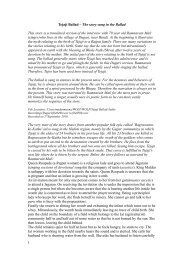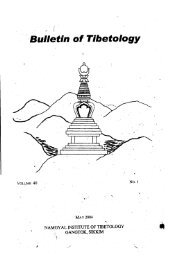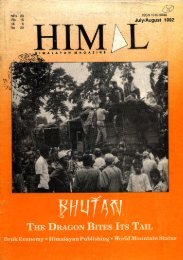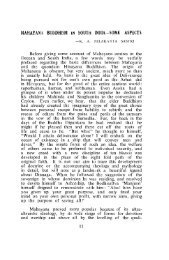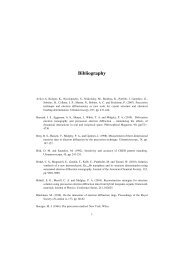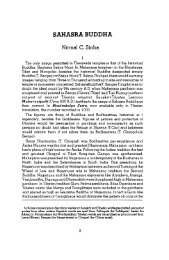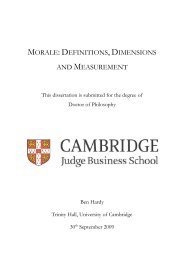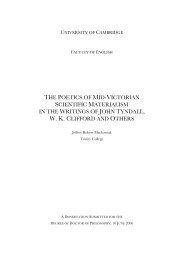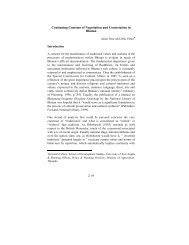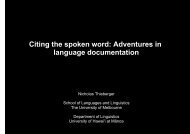The Crusades, the Genoese and the Latin East - DSpace at ...
The Crusades, the Genoese and the Latin East - DSpace at ...
The Crusades, the Genoese and the Latin East - DSpace at ...
Create successful ePaper yourself
Turn your PDF publications into a flip-book with our unique Google optimized e-Paper software.
within cities along <strong>the</strong> shoreline. This evidence thus calls us to re-examine Jon<strong>at</strong>han Riley Smith'<br />
hypo<strong>the</strong>sis th<strong>at</strong> <strong>the</strong> number of Europeans who were `engaged in <strong>the</strong> traffic of merch<strong>and</strong>ise... <strong>and</strong><br />
organising caravans from Damascus <strong>and</strong> o<strong>the</strong>r Muslim centres to <strong>the</strong> Levantine sea-board must<br />
have been negligible. "99 <strong>The</strong> merchants who headed north in 1203 faced some complic<strong>at</strong>ed<br />
challenges. <strong>The</strong> Continu<strong>at</strong>ion of William of Tyre described how a small group of crusaders left<br />
Acre in <strong>the</strong> same year <strong>and</strong> travelled towards Antioch. On <strong>the</strong>ir way <strong>the</strong>y passed by enemy<br />
territory, not far from Jabala, which was in <strong>the</strong> h<strong>and</strong>s of <strong>the</strong> ruler of Aleppo. <strong>The</strong>y were <strong>at</strong>tacked<br />
by <strong>the</strong> Muslims <strong>and</strong> were eventually defe<strong>at</strong>ed near L<strong>at</strong>akia 200 According to Heyd, <strong>the</strong> hostile<br />
<strong>at</strong>mosphere between <strong>the</strong> Christians <strong>and</strong> Muslims in <strong>the</strong> nor<strong>the</strong>rn regions of <strong>the</strong> crusader st<strong>at</strong>es<br />
remained so until 1207. Heyd believed th<strong>at</strong> 1207 marked a turning point in <strong>the</strong> rel<strong>at</strong>ions between<br />
Christians <strong>and</strong> Muslims in <strong>the</strong> north, when a commercial pact was signed between Venice <strong>and</strong> al-<br />
Malik az-Zähir, son of Saladin201 Evidence from <strong>the</strong> notarial contracts provides a different<br />
impression of <strong>the</strong> rel<strong>at</strong>ionship between Christian travellers <strong>and</strong> <strong>the</strong> Ayyubids <strong>at</strong> <strong>the</strong> beginning of<br />
<strong>the</strong> thirteenth century, especially with regard to commercial rel<strong>at</strong>ions. How should <strong>the</strong> evidence<br />
from <strong>the</strong> <strong>Genoese</strong> sources be interpreted? <strong>The</strong> contracts were <strong>the</strong> fruits of a political change th<strong>at</strong><br />
must have taken place before 1203. When did <strong>the</strong> rel<strong>at</strong>ions with Aleppo change, <strong>and</strong> wh<strong>at</strong><br />
motiv<strong>at</strong>ed such a change?<br />
<strong>The</strong> importance of Aleppo had already been recognised <strong>at</strong> <strong>the</strong> time of <strong>the</strong> First Crusade.<br />
Aleppo was considered a str<strong>at</strong>egic key place in <strong>the</strong> eyes of <strong>the</strong> Muslims in Syria as well as <strong>the</strong><br />
crusades <strong>and</strong> <strong>the</strong> <strong>L<strong>at</strong>in</strong> inhabitants of <strong>the</strong> nor<strong>the</strong>rn st<strong>at</strong>es. Aleppo was considered an important<br />
agricultural centre especially for <strong>the</strong> production of cotton <strong>and</strong> it was famous for its glass<br />
industry202 More importantly, however, was <strong>the</strong> loc<strong>at</strong>ion of Aleppo because it st<strong>and</strong>s in a junction<br />
of one of <strong>the</strong> leading trade <strong>and</strong> hajj routes between <strong>the</strong> Mediterranean <strong>and</strong> <strong>the</strong> east (Figure 4).<br />
Evidence from <strong>the</strong> beginning of <strong>the</strong> twentieth century reveals th<strong>at</strong> Aleppo maintained its<br />
centrality as l<strong>at</strong>e as <strong>the</strong> First World War (see Figure 5).<br />
''Jon<strong>at</strong>han Riley Smith, `Government in <strong>L<strong>at</strong>in</strong> Syria <strong>and</strong> <strong>the</strong> Commercial Privileges of Foreign<br />
Merchants', in Derek Baker, ed., Rel<strong>at</strong>ions between <strong>East</strong> <strong>and</strong> West in <strong>the</strong> Middle Ages (Edinburgh, 1973),<br />
115.<br />
2La Continu<strong>at</strong>ion de Guillaume de Tyr, in RHC. Oc., vol. 2, pp. 247-249; Wilhelm von Heyd, Histoire du<br />
commerce du Levant au moyen-age (Amsterdam, 1959), vol. 1, p. 373.<br />
201 Heyd, Hisotire de commerce, vol. 1, pp. 374-375; Eliyahu Ashtor, A Social <strong>and</strong> Economic History of <strong>the</strong><br />
Near <strong>East</strong> in <strong>the</strong> Middle Ages (London, 1976), pp. 240-241.<br />
202 Ashtor, A Social <strong>and</strong> Economic History, pp. 97,242-3,275-8; David Abulafia, `Trade <strong>and</strong> Crusade:<br />
1050-1250', in Michael Goodich, Sophia Menache <strong>and</strong> Sylvia Schein, Cross Cultural Convergences in <strong>the</strong><br />
Crusader Period. Essays Presented to Aryeh Grabois on his Sixty-Fifth Birthday (New York, 1995), p. 15.<br />
67



